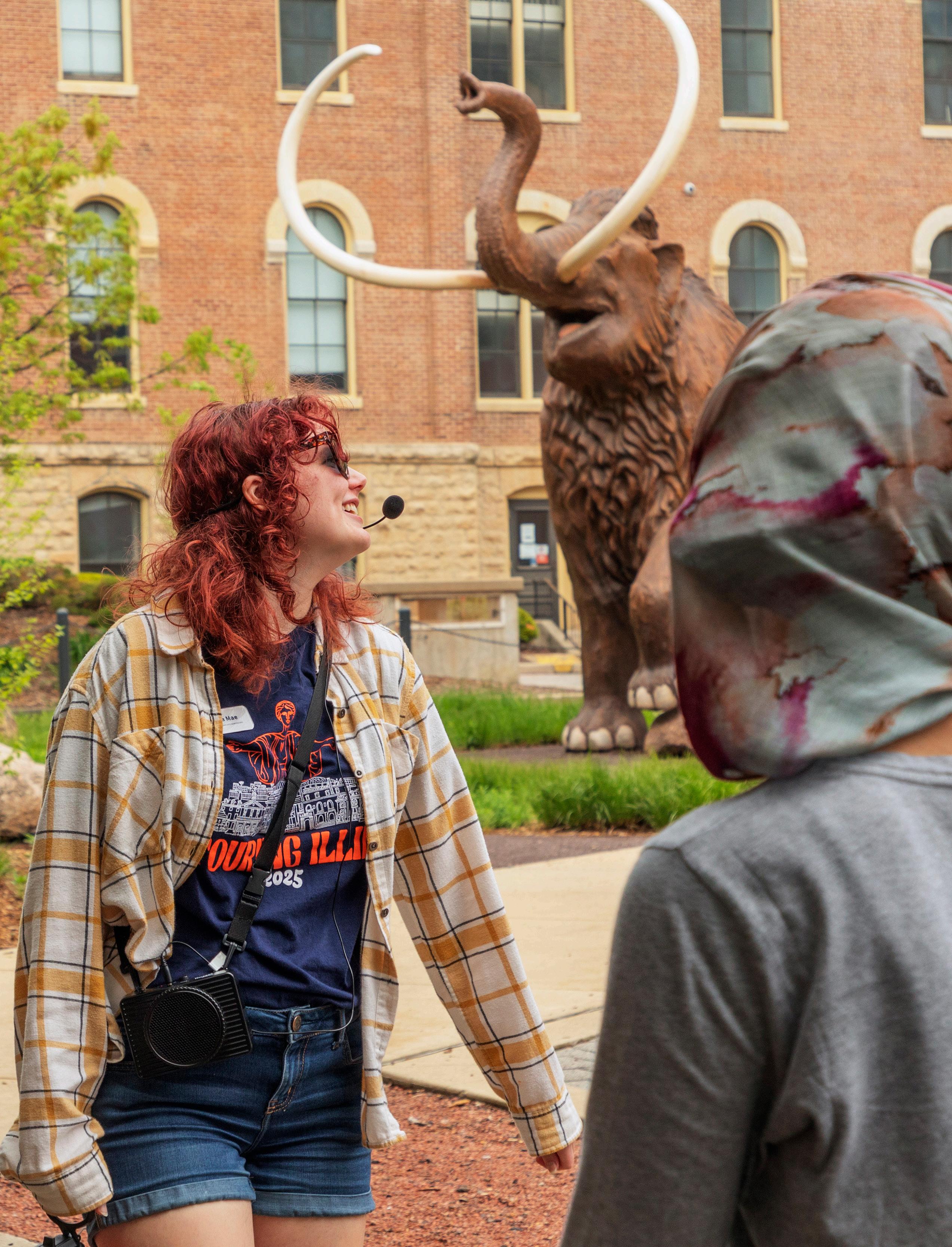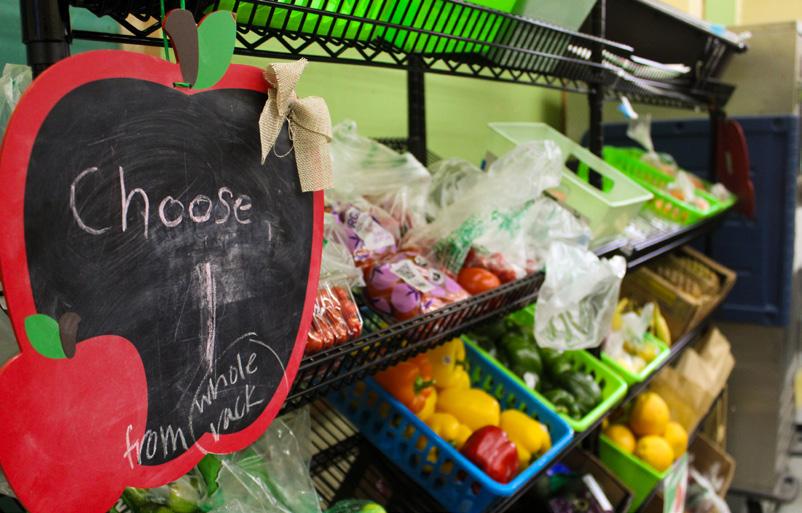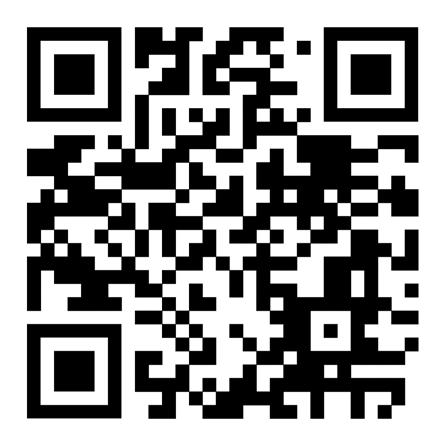




SENIOR COPY EDITOR ALEXA LIS arlis3@dailyillini.com
Here’s a secret: College is expensive. Whether you’re in-state or out-of-state, fresh out of high school or coming from a community college, there’s no question that the price tag called “tuition” is something to take seriously.
Luckily, the University is aware of this and has various cost-free programs to give students the biggest possible bang for their buck.
Here are three free-for-student programs you can get involved with to make your time at the University enjoyable.
The Stress Management Program, tucked away within the Health Education branch of the McKinley Health Center, is a highly active program for all students who may need support in tackling their day-today challenges.
Jeanine Bensken, stress management coordinator at McKinley, spoke passionately about the program’s various aspects and goal of reaching as many students as possible.
One of the primary facets of the program is its network of Stress Management Peers, which consists of students who learn stress management techniques for themselves and how to help others manage stress.
Bensken and the Stress Management Peers hold tables at several campus buildings four days a week, providing a
stress management theme of the week, resources like selfcare checklists and, most importantly, smiling faces.
“We are aiming for consistency and connection,” Bensken said about the program’s presence at tables around campus. “The consistency of, ‘Hey, if you don’t know where to go, we’re here every week.’”
Spread across the table were numerous resources, including a flyer with their weekly schedule and positive, uplifting stickers. The table also offered a plethora of mental health resources, like a daily self-care checklist, a wellness wheel and QR codes for more mental health resources on the McKinley website.
“(The Stress Management Program) is open to you and you’re welcome,” Bensken said. “Come find what helps you. This is a vibrant campus, and we’re here to help.”
The Writers Workshop has been helping students and faculty with all their writing needs for 35 years and counting.
Carolyn Wisniewski, senior director of the Writers Workshop, wants students to know they are there for more than just your basic essay.
Students and faculty can turn to the Writers Workshop for help with any piece of writing, from cover letters to poster presentations to graduate and undergraduate theses.
At any stage in the writing process, the Writers Workshop is there to help. Students can make an appointment with a Writers

Workshop consultant before they have even begun writing to get guidance in streamlining their ideas.
“I think sometimes there’s a myth that the Writers Workshop is only for, quote-unquote, ‘bad’ writers, but we’re for everybody,” Wisniewski said. “I like to say that we’re just the biggest writing cheerleaders on campus.”
A bit of a trek from campus, the Sustainable Student Farm is located on South Lincoln Avenue. It operates six acres of land to grow many varieties of produce throughout the year.
Any student can become involved on the farm as a volunteer, a hired staff member during the fall harvesting season or a summer intern.
“One of the nice things and challenging things about vegetable production is that there’s lots of different things to do all the time,” said Matt Turino, director at the SSF.
As volunteers or student workers on the farm, students gain hands-on experience in all aspects of vegetable growing.
Students learn about planting, harvesting and weeding, as well as how to sell produce at the SSF’s weekly farm stand, which runs each year from late May through the fall semester. The SSF also sells its produce through an online store.
When asked about some highlights of his work as director, Turino proudly spoke of the education and experience that students receive on the farm.
“It’s really rewarding to hopefully inspire the same kind of lightbulb moment that happened to me while I was a student worker,” Turino said. “Even if you don’t become a farmer, hopefully, you have a greater appreciation for what the process looks like and why vegetables might cost a little bit more at the farmers market than at the grocery store.”




5 storylines to keep your eye on in the upcoming academic year
ASSISTANT SPORTS EDITOR
SAHIL MITTAL
sahilsm3@dailyillini.com
There’s always a lot going on with Illinois sports, but this fall features a whole new set of intriguing storylines for fans to follow. From basketball to tennis to football, here are five mustknow sports stories new and old Illini sports fans should pay attention to.
Illini men’s basketball just got a whole lot bigger. Seven-foot-one rising junior center Tomislav Ivišić was a major part of the 202425 Illini squad, and he is returning to the team next season. However, he’s not the only Ivišić in Champaign any more.
Illinois went into the transfer portal and landed Ivišić’s twin brother, Zvonimir Ivišić, a rising junior who played at Arkansas last season. At 7-foot-2, Zvonimir forms an intriguing pairing in the frontcourt with Tomislav. After being teammates all their lives, the two played against each other for the first time last season. Now, they will reunite in Champaign under the leadership of assistant coach Orlando Antigua, who recruited them to play college basketball in the United States.
Both brothers can stretch the floor and shoot the three while being good rim protectors. This gives Illinois a unique scenario with two 7-footers who can play inside and out.
Head coach Brad Underwood must determine how often the brothers can play together in the lineup. Regardless, it will be a fun sight to see at State Farm Center when they grace the court together.
Illinois is known as a basketball school, but this started to change last year. The Illini had a fantastic season in 2024, going 10-3. It was their first 10-win season since 2001, and their Cheez-It Citrus Bowl win helped them finish at No. 16 in the AP Top 25 poll.
Multiple key pieces from last year’s squad are to return in 2025, including rising senior quarterback Luke Altmyer, rising senior defensive back Xavier Scott and rising senior linebacker Gabe Jacas, preserving the experience of last year’s team.
Head coach Bret Bielema has also been active, recruiting talent from high school and the transfer portal to bolster the roster in 2025 and 2026. Illinois currently has a top-10 recruiting class for 2026. It should help ease the
transition as key seniors leave after this upcoming season.
Many have seen Illinois’ 2025 schedule as relatively favorable, with most media members and fans expecting roughly three losses. The Illini should finish anywhere from 8-4, given if they falter in a few games, to 10-2 if everything goes right.
The schedule’s highlight is a challenging home matchup with Ohio State in Week 7. Similarly, a Homecoming showdown with USC is sure to bring out the energy in Illini fans.
Illini men’s tennis added a star freshman heading into the 2025-26 season. Australian Hayden Jones will make his collegiate debut this fall after starring on the world stage in recent years.
Jones’ resume is already impressive. He boasts a career-high International Tennis Federation junior ranking of No. 8 worldwide and has competed in professional events, having Association of Tennis Professionals rankings in both singles and doubles.
Jones’ play earned him wild cards into the qualifying draws of the 2024 and 2025 editions of the Australian Open, one of the four major tournaments on the professional tour.
“Hayden’s competitive
spirit will pay big dividends for the Illini, and we are looking forward to coaching Hayden and helping him grow toward becoming a top ATP professional,” said head coach Brad Dancer in a press release.
Jones’ experience in the highest levels of junior competition and the early stages of professional play should give him all the tools to be an immediate impact player for the Illini in the fall. He is the cherry on top for a stellar group of four incoming freshmen, which includes highly touted blue-chip recruit Sasha Colleu.
Under the leadership of head coach Shauna Green, women’s basketball at Illinois has exponentially improved in the past few years.
From winning the inaugural Women’s Basketball Invitation Tournament title in 2024 to most recently being named a No. 8 seed in the NCAA tournament and winning their first tournament game since 2000, the Illini are on the rise. They finished last season with 22 wins, tied for third-most in program history.
An outgoing trio of seniors, forward Kendall Bostic, guard Genesis Bryant
and guard Adalia McKenzie, were a major part of that success. In their absence, Illinois has a star freshman entering to make her mark.
Chicago native and fivestar guard Destiny Jackson will make her debut for her home-state program this fall, and she’s sure to be a major piece from the get-go. Jackson was named the 2025 Illinois Ms. Basketball after a stellar senior season at Whitney Young High School, averaging 21.1 points, 7.5 rebounds, 3.5 assists and 2.8 steals.
“I chose the University of Illinois because it felt like home from the moment I stepped on campus,” Jackson said in a press release. “Growing up in Illinois, I wanted to stay connected to my roots, and Illinois gives me the perfect balance of familiarity and new opportunities.”
Jackson’s ability to shoot
the three, score off the dribble and put pressure on defenders when attacking will be a valuable asset for the Illini this fall and throughout the season.
She is the second-ever five-star recruit for the Illini and will play alongside rising sophomore forward Berry Wallace, the program’s first five-star player. Wallace played a key role for an Illini roster that struggled with injuries last season.
“I believe in the vision the coaching staff has for me and for the team, and I’m excited to be part of a program that values me and my potential as both a player and a person,” Jackson said.
Ty Rodgers shocked Illini fans when he decided to redshirt last season just
moments before opening night. As a sophomore, Rodgers had been a key piece of the 2023-24 Elite Eight team, starting every game for the talented roster.
However, for reasons never publicized, Rodgers did not play last year. It was rumored that he would not have gotten the role he expected, with Will Riley and Tre White — neither of whom will return for this coming season — taking a large chunk of his minutes.
Many expected Rodgers to transfer following last season. But against the odds, Rodgers made the decision to return to Champaign.
Those in the program spoke highly of him as a teammate during his redshirt season, and he was seen actively coaching and providing advice during games.
When Morez Johnson Jr. and White decided to transfer, that opened up more of a role for Rodgers.Add in the fact that he is beloved by the Illini community, and it made perfect sense for him to return.
“I love it here, man,” Rodgers said. “It’s my home. There’s no place I’d rather be. You know, I’m comfortable here. I love the community. I feel like the community loves me. I feel like I’ve got an opportunity to achieve all my dreams here.”
Along with Rodgers returning, the Illini have rising senior guard Kylan Boswell, rising junior wing Jake Davis and Tomislav returning. Senior walk-on guard AJ Redd and redshirt freshman forward Jason Jakstys will also help bring continuity of culture and familiarity to next season’s team after lacking that this past year.

NEWS EDITOR
QAASIM JATOI qjato2@dailyillini.com
On any given night in Campustown, it’s common to see UIPD cruisers weaving through traffic on Green Street. The lights aren’t always flashing, but their presence is unmistakable — part of a broader shift in campus policing recently.
Since October 2022, UIPD has taken over primary patrol responsibility for the Champaign side of campus. The area — home to bars, apartments and dense foot traffic — was previously under the Champaign Police Department’s jurisdiction.
UIPD now handles everything from theft reports to wellness checks, leading to a sharp rise in calls — 12,000 in 2021 to 21,000 in 2024.
“Calls for service have gone up significantly, not just because of the jurisdiction change, but the increasing residential population and student enrollment as well,” said UIPD Captain Jason Bradley in an email to The Daily Illini.
According to UIPD’s 202223 annual report, the most common calls involved theft, traffic incidents, mental health crises and alcohol violations. While violent crimes were rare, police responded to multiple reports of aggravated battery, robbery and sexual assault.
To meet increased demand, UIPD has hired community service officers to handle less serious calls and expanded its Community Outreach and Support Team. COAST, operating
from the Green Street substation, focuses on proactive engagement.
Another pillar of the department’s approach is REACH — Response, Evaluation and Crisis Help — a corresponder model launched in 2021 that pairs officers with licensed social workers for mental health crises.
“With this program, our community can talk to a trained practitioner in person, in their own space and during hours where other services are not traditionally available,” Bradley said.
Per UIPD policy, officers first secure the scene. Social workers then assess the individual and determine the next steps, like counseling referrals and safety planning.
Communication is another key aspect of public safety. Students often ask why some, but not all, incidents trigger campus-wide alerts.
Under federal Clery Act regulations, universities must issue notices of ongoing threats to campus. The University also sends Illini-Alerts during im mediate emergencies.
“Campus Safety No tices may be a series of burglaries with remind ers to practice good habits like locking your doors,” Bradley said. “They may also be crimes against persons, such as sexual assault.”
Some alerts may seem vague — a delib erate choice,
according to Bradley.
“Overly specific locations can lead others to find out who the victim was,” Bradley said. “Our balance is to effectively warn the community … but also to protect victims.”
Beyond response and communication, UIPD’s 2022-23 annual report includes arrest data. That data raises questions about equity in enforcement.
From July 2022 to June 2023, Black individuals made up 39.6% of all arrests. By contrast, Black residents make up just 17.4% of Champaign’s population and only 6.3% of the student body. Over half of Black arrestees were jailed, compared to 28% of white arrestees.
“These are constant conversations, and UIPD takes a very serious look at all our practices to ensure equity,” Bradley said.
Bradley cited UIPD’s Tier II state accreditation and said
ademic year. Topics included civil rights, de-escalation, mental health and cultural competency.
But a March CU-CitizenAccess investigation added nuance to the picture. Records showed officers completed below average hours. The report also noted that cultural competency and civil rights training are only required every three years.
In another investigation, CU-CitizenAccess found that since 2014, UIPD stopped Black and Asian drivers at higher rates than their population share. Bradley told them UIPD has no formal initiatives outside of existing policy to reduce potential issues or bias in traffic enforcement.
Some students described respectful interactions with police. Others alleged racial profiling, dismissiveness during medical distress or unwarranted searches.

While UIPD emphasized its commitment to equity, it also framed many disparities as outcomes of broader societal factors. In its annual report, UIPD said systemic inequalities, including disparities in housing, access to mental health resources and income, often shape arrest trends and public safety outcomes.
“We’re aware of attitudes in the national discourse … and we understand those can cause anxiety and fear,”
Bradley said. “We’ve built and maintained a strong tradition of trust and professionalism with our campus … We have to earn that trust every day and in every interaction.”
MANAGING EDITOR
MAAIKE NIEKERK
maaiken2@dailyillini.com
It might be difficult to see what’s so special about Champaign-Urbana, a college town surrounded by cornfields. But hidden within its bustling campus, the community has something unique to offer — a lively music scene.
Beyond its nightly shows, each C-U venue has a rich history and culture. The Daily Illini spoke with organizers at different locations to learn more
Urbana. Despite its casual demeanor, this officially began the vibrant history of Rose Bowl Tavern, one of C-U’s oldest music venues.
“It was pretty much just the town bar, tavern sort of vibe, and they would just have bands set up in the corner or whatever,” said Charlie Harris, current partowner of Rose Bowl.
According to Harris, Rose Bowl was purchased in the ’60s by Sunny Norman, a musician who originally worked as the building’s janitor. Norman and his wife rebranded Rose Bowl as “the
acknowledging this rich history, Harris doesn’t choose to see the bar as a space that’s exclusive to country music.
“The aesthetic is still that sort of old honky-tonk inside,” Harris said. “A number of the signs outside say ‘Home of country music.’ And we do a lot of country and country-adjacent (music) … We don’t think of ourselves as a country bar, even though those signs are up, and the inside has that old-school vibe.”
Harris came into ownership of Rose Bowl
on Monday nights. The venue’s third owner, Steve Campbell, approached Harris about taking over the venue, which he did in 2019.
Under its current ownership, Rose Bowl has continued to host live music every night — just like it did in Norman’s days. It holds trivia nights, jazz jams, local groups and touring artists for the campus and community to enjoy. All of this, Harris emphasized, goes toward bringing the community together and keeping performances accessible.


Harris said. “We’re trying to keep drink prices and cover charge low so people can enjoy it on a regular basis.”
In the late ’60s, the University — and the country as a whole — were undergoing significant cultural shifts. This included the height of the Vietnam War and the tail end of the Civil Rights movement.
During it all, Herman Krannert, University alum who studied engineering, and his wife, Ellnora Krannert, saw a need in the student population. It wasn’t for another engineering laboratory but for a worldclass performing arts venue in the community.
“I’ve joined others in referring to Krannert Center as sort of this ‘miracle on the prairie,’” said Mike Ross, director of KCPA. “I believe it’s unique within the realm of higher (education).”
Created by School of Architecture alum Max Abramovitz, Ross said he “conservatively” estimates the building is valued at around $350 million.
Abramovitz is known for working on iconic buildings in New York City, like Lincoln Center and the United Nations Headquarters, as well as State Farm Center.
Ross shared the Krannerts’ sentiment of bringing the gift of the arts to University students. He emphasized the importance of not only indulging students studying music and performance in its culture but also everybody on campus.
“It’s always been my goal to help make Krannert Center a place, a source of experience for every student
on campus, and in different ways, too,” Ross said. “I’m the first to acknowledge that every individual human being has different interests, different preferences. We’re all walking through life at different stages, along different pathways, coming from different places.”
The student-first angle has been at the front of Ross’ mind since he took over as the KCPA’s sixth director in 1997. KCPA has followed through on its initiative to provide $10 tickets to University students, something that Ross feels particularly passionate about.
“That was an initiative that I felt was very important for us to launch,” Ross said. “Breaking down the financial barriers is part of what has helped bring more students in.”
Ross said that relative to other venues at universities across the country, student attendance and participation at KCPA sits “in the very, very top thin slice of participation.”
Lowering student ticket prices isn’t the only move KCPA has made to boost inclusivity and student participation. While the it has five stages, the lobby’s Stage 5 was created to bring a more open, club-like vibe to a venue that could otherwise appear quite formal, according to Ross.
The Krannerts’ gift has given the University its own “Lincoln Center” of the Midwest — as Ross has heard it called across the country. More than anything else, it provides students with a truly unique concert experience right in the middle of their campus.
“I’m passionate about
this place,” Ross said. “I think it’s an extraordinary gift to all of us.”
Just down the block from KCPA, a smaller venue is tucked between Timpone’s and The Bread Company on South Goodwin Avenue. With a different energy entirely, The Canopy Club has opened its doors for nightly entertainment since 1998.
“When it started out, it was kind of a grungy rock club, right?” said Kate Turk, director of special events for Jay Goldberg Events & Entertainment, The Canopy Club’s parent company. “It was an old theater that had been transformed into a music venue by people who just really wanted to see shows.”
The venue has held similar values to Rose Bowl and KCPA since its humble beginnings, particularly in wanting to be as inclusive as possible.
Turk said the club got its name because “there’s a place for everybody in the rainforest, and there’s a place for everybody at The Canopy Club.”
With brightly painted walls, an array of colored lights and disco balls dangling from the ceiling, The Canopy Club hosts a range of sights and sounds for students to enjoy. These include themed nights from K-pop to Taylor Swift, drag shows, local acts and touring artists. The decorations, Turk emphasized, help to create more of an all-encompassing event rather than just a venue.
While The Canopy Club started with a strong focus on rock, Turk said the venue has evolved over the years to match what students want.
According to her, it
achieved its reputation by staying a few steps ahead of the popular music trends, which included taking chances.
“We’re happy to take the risk on doing something that’s a little bit different and maybe not something that other venues would want to take a risk on,” Turk said. “It started out as a straight music venue — and it still is a straight music venue, but I would like to think it’s a little bit more of an experience at this point.”
Robert Kjev, marketing associate at Jay Goldberg Events & Entertainment, has watched the venue grow since its beginnings when he was a regular at the club. He discussed how its dedicated following has made it unique among other venues in the area.
“We’re at a point now where people’s kids are now coming to the club,” Kjev said. “We’re on generation two … I had the realization; it’s completely unprecedented as a music venue around here, but just as far as a business in general, how many have a 25-year lifespan and are still going like this?”
Since its opening, The Canopy Club has hosted numerous big names, including Chance the Rapper, Fall Out Boy, The Chainsmokers and Smash Mouth.
According to Turk, the club has a knack for catching artists before they achieve global fame — which should motivate students to attend local concerts.
“It’s a really good experience to go to any of these places,” Turk said. “Our local music scene is fantastic. I really hope that more people decide they want to go out and spend their Friday night checking out a band and supporting somebody locally.”




SENIOR COPY EDITOR
HELEN MAURER
hmaurer2@dailyillini.com
Many University students will frequent a popular Green Street destination at least once during their time here, but they might not know the history behind the iconic street. Green has a rich and deep history that spans over a century, and each decade brings a new generation of establishments overtaking the old.
However, Green didn’t always have a flourishing social scene. It originally started as a hub for Greek houses and residential homes for faculty.
Green has adapted over time, and some community members say it’s lost the spark that small businesses added to the community. Chain businesses and residential high-rises are filling Green, resulting from the large investment Champaign put into fixing its flood problem.
Boneyard Creek once consistently overflowed and flooded the surrounding streets, including Green. However, in the early 2000s, the City of Champaign invested in restructuring the layout of Green, fixing the flooding issue and creating a more stable environment for property development.
Adviser and professor in FAA Ben LeRoy explained how the investment changed the trajectory of businesses on Green.
“There was then a lot more willingness by private real estate capital to invest in Green Street,” LeRoy said. “A lot of it is driven by this invisible infrastructure story about making sure things stay dry on Green Street.”
Now that the City of Champaign has developed Green’s infrastructure, LeRoy stressed that property owners charge more in rent, leading to larger business chains being the lone market able to afford it.
This has weeded out iconic, culturally significant businesses that had been on Green for decades.
However, not everyone feels the same way about these advancements. Dr. Mahmoud Elrakhawy, a 2015 University alum and professor in Medicine, returned to Champaign-Urbana to work as a surgeon at the Carle Foundation Hospital and teach at the University.
He had a different opinion of Green when asked about the gradual changes.
“The thing with Green Street is, even if the establishments close, new ones pop up that seem to do — I don’t want to say a better job — but a more efficient or modernized service, so I don’t think I necessarily miss any establishment,” Elrakhawy said.
The high-rises on Green didn’t exist during Elrakhawy’s time at the University, so when he returned to


C-U, the change was dramatic to him.
While Green’s infrastructure has surely altered, most are unaware that Green used to have a budding music scene, especially during the ’70s and ’80s when live music was at its peak.
Mabel’s was a prime music club on Green, hosting hundreds of bands and open seven nights a week. Its lineup included groups like The Smashing Pumpkins and Nirvana.
The rise of platforms like MTV caused a huge upward trend in live music, which traveled quickly to C-U.
The owner of Mabel’s, Paul
Faber, discussed the live music craze in the University’s Storied Magazine.
“Every night you could see a band and the place would be packed,” Faber said. “People were really hungry for live, original music back then. It was just amazing that we could get that quality of acts for that small of a club.”
DJ booths have replaced the vibrant scene, and live music is no longer available on Green.
It’s safe to say that Green will continue to evolve, and it’s fun to predict what hotspot will be the next cultural icon to look back on decades in the future.


SPORTS EDITOR
BRENDAN GALLIAN bdg4@dailyillini.com
The phrase “campus wildlife” likely brings a few species of animals to mind, specifically squirrels, geese and crows. These three are very prevalent at the University, but they’re far from the only species on campus.
“You see squirrels and geese and crows on a regular basis,” said Joy O’Keefe, professor in ACES. “But there is a lot of other wildlife that comes through campus — things that are hidden, and you might not notice.”
Birds are one of the most common types of “hidden wildlife.” The University lies on a major migration route called the Mississippi Flyway, where birds flying over often stop to rest.
“I could go out on campus and find 80 species of
campus, you’ll see all kinds of birds.”
Other than crows and geese, Ward named the American robin, dark-eyed junco and various species of sparrows and finches as common birds on campus. One can see a dozen different species during a single walk between classes, according to Ward.
In the spring, the honking and hissing of a Canada goose could interrupt that walk. These feisty birds have established a presence at the University, which serves as a paradise amid a sea of corn and soy.
“Campus is perfect,” Ward said. “Lots of green grass that’s mowed so they can eat it all day long. There’s places for them to nest. There’s water.”
Ward said the geese on campus are used to people but are still quick to hiss at anyone who gets too close.
The hissing acts as a warning before they resort to bit

Survey, tracks Illinois’ mammals using cameras. A wide range of species are present on campus, according to Proudman.
“Keep your eyes open for red foxes,” Proudman said. “They’re definitely in town because we recently put a collar on a red fox, and we’ve seen their movements around.”
Proudman also said trail cameras captured gray foxes and southern flying squirrels near the University. However, the most common mammal on campus is the eastern gray squirrel.
“Squirrels are the ones you’re going to encounter all the time when you’re walking,” Proudman said. “They’re pretty adept at living in these urban spaces now.”
This wasn’t always the case. In fact, years of hunting and deforestation nearly eradicated squirrels from the state by 1900.
In 1901, geology professor Charles Rolfe and University President Andrew Draper launched a plan to return the rodents to cam pus.
The pair im ported squirrels to the area but encountered early set backs. Some squirrels didn’t sur vive the trip, while humans and dogs hunt ed the ones that
did. Discouraged by the results, the duo abandoned the plan.
However, by 1919, the few remaining squirrels established a substantial population on campus.
Like squirrels once did, a few new species could make their way to the area soon.
Armadillos have been marching north for decades and have recently arrived in southern Illinois. In 2017, an armadillo was spotted at Urbana High School, just a mile east of campus.
Proudman also said bobcats are arriving in Champaign County but will likely avoid campus and urban areas.
No matter what species appear on campus in the coming decades, it will continue to act as an animal haven.
“There’s a lot more wildlife here than there is in other places,” Ward said. “I don’t think people

JAHZARA NORRIS jahzara2@dailyillini.com
Several food pantries and free meal programs can be found across campus. While some options are specifically geared toward those facing food and nutrition insecurity, many are open to University students. If you know where to look, it’s possible to secure a free meal nearly every day of the week.
Located inside the ARC Instructional Kitchen, the Food Assistance & Well-Being Program is a University-run initiative that provides free groceries and snacks to students.
The Food Assistance & Well-Being pantry is open twice a week — Tuesdays from 1-4 p.m. and Saturdays from 2-5 p.m. The program also has a grab-and-go locker at CRCE, which is open from 4-6 p.m. on Mondays and Wednesdays.
Rachel Yang, assistant director of food security at Campus Recreation, said its mission is to ensure all students have access to nutritious food and reduce stigma around using this type of resource to alleviate food insecurity.
“(Food insecurity is) not something people really talk about, so being able to provide space that they feel welcome to get the resources they need really is important,” Yang said.
Located on the second floor of Bevier Hall, Bevier Café is a restaurant in partnership with University Housing’s Everybody Eats program. The café is open from 11:30 a.m. to 1 p.m. Monday through Friday when classes are in session.
At Bevier Café, students have several payment options: the menu price, more than the menu price, another student’s meal in addition to their own or a free meal token.
Everybody Eats has two hot box locations inside the SDRP and Illinois Street Residence Halls. These boxes are available daily from 10:30 a.m. to 8 p.m. and contain free soup and rice for anyone in need of a hot meal.
The Wesley Food Pantry is run by Wesley United Methodist Church, located on the corner of Green and Goodwin streets, and open to all Champaign-Urbana residents.
According to Dawn Longfellow, director of the Wesley Food Pantry, the core mission of the pantry is to provide groceries to those who are struggling and to reduce food-related anxiety.
“Really, we want to be a safety net for people that are in a position where they’re not receiving government assistance, but they’re also not quite making their budget stretch,” Longfellow said.
The pantry is open from 5-7 p.m. on Thursdays, offering fresh produce, meats and snack items. The pantry also occasion-

ally provides commercial goods, like toiletries when available, as well as recipes.
The Wesley Food Pantry has multiple satellite locations specifically for University students: a store-like pantry in the ARC Instructional Kitchen and a grab-and-go location in the Main Library’s Orange Room.
Every Saturday afternoon from 1-2 p.m., the McKinley Foundation offers a free dinner for University students at Presby Hall. All students are welcome, regardless of need, to enjoy a free meal and socialize.
“The focus is to help food-insecure students but also to provide a safe space where people can meet and gather,” said Paula Hancock, executive director of the McKinley Foundation.
The Community Dinner program hosts cafeteria-style hot food with vegetarian options, and students are encouraged to take home any food that is left over afterward.
Jubilee Cafe is a dinner program for community members and students hosted by the Community United Church of Christ. Every Monday from
The produce shelf at the Wesley Food Pantry in Urbana on April 24 displays free fruits and vegetables.
5-6:30 p.m., students can stop by the church to pick up a free dinner. Additionally, CUCC offers low-cost pantry items for its guests.
Lunch on Us is a free lunch and lecture program hosted by Student Affairs. Each day of the week, a different cultural house welcomes students to grab food and participate in a group discussion and lecture about various topics from noon to 1 p.m.
While discussions typically deal with a specific topic related to each house, all are welcome to participate.
Although not a part of the cultural house series, another notable mention is the “Friday Forum + Conversation Café” lunches hosted at the University YMCA at noon. Friday Forum features a free meal from the Y-Thai Eatery along with a discussion surrounding pressing public concerns.
More information can be found at the “Eat. Move. Save.” page on the University website, which contains an interactive map with the locations of every food pantry and free food service in the C-U area.
The Daily Illini assembles Best of CU annually — a classic print edition that polls campus and community members alike on their favorite Champaign-Urbana hot spots. For over a decade, this annual publication has represented the C-U community’s opinions on restaurants, local businesses, campus haunts and more. The following photo gallery highlights just a few of the many different category winners. For more, check out Best of CU on our website!



Attendees at The Canopy Club raise their arms in the air as they jam out to a DJ set on Jan. 29.


A waitress brings out plates of steaming hot toast, eggs, biscuits and gravy to a table on Feb. 28. Merry-Ann’s Diner is located on the corner of Kirby Avenue and Neil Street in Champaign.

The Bread Company’s grilled turkey sandwich with pesto, gruyere, tomato and onion on Feb. 19. The sandwich is one of the restaurant’s bestsellers.
Two comfy seats adjacent to Caffe Paradiso’s entrance offer a peaceful space for customers to enjoy their meal


Tables in the Main Library’s reading room are full of students studying for midterms on Feb. 18.




SATIRIST CAMPUS SCOUT
scout@dailyillini.com
Attention all incoming students: do not attend this University, or risk a terrible fate.
The blood moon rises and Pluto breaches its fifth dimension, signaling mortal danger for all University students in the fall semester, according to leading experts.
Ever since a long year including a failed presidential campaign and the closing of Rainforest Cafe’s New Jersey location, Scout has laid low — until now. He has volunteered to lead the campus’ newly formed task force in the Department of Magic and Spell-Casting.
Our blue omnipresent observer of campus life has always been in tune with his spiritual side. Now, however, he faces a startling challenge in defending the University from the other side.
He makes his warning clear. All freshmen in the fall semester should turn tail and flee from the cornfields before it’s too late. It won’t be long until Champaign-Urbana devolves into a supernatural battleground not even Murray and Aykroyd could temper.
Thanks to the simultaneous conjunction of Saturn and Uranus, there is a heightened level of mystic energies
in the atmosphere, measured in MILFs — Magic Inside Lightning Flasks. These show that a conflict as old as time will converge over these beautiful manure-stained skies.
As recorded in Scout’s first briefing to his special task force, the beginning signs of the coming war will be apparent. They will start with professors suddenly calling out “sick” or assigning heaps of homework right off the bat. This can only mean one thing — your professor is a werewolf.
Lycanthropy is a misunderstood affliction. Every month at the full moon, the person suffering from it transforms into a massive furry creature with a hankering for raw flesh. The converging of Europa over the trajectory of Pluto will jumpstart these transformations. This will force your physics professor out of the lab and into their office, where they will howl for hours.
Scout’s completely legitimate task force will consume University funds, but save students’ lives — so it’s a good thing.
With the absorption of Venus’ light rays into the lithosphere, there is a high likelihood of a perilous Squirrel Uprising. The creatures are tuned into the humming of the Spirit Realm and will naturally in-
take the brunt of the MILFs.
If a squirrel approaches you and your freshmen friends, this is highly unnatural. Obtain a flame-emitting device (provided by our friends at Talbot Laboratory!) and rid the world of that fiendish beast as soon as possible.
With the electrifying power of 30,000 MILFs in the stratosphere of planet Earth, Scout confirms we are careening toward an all-out showdown between the forces of living and dead.
The University’s new Chancellor will have their hands full with class schedules shifting due to onslaughts of stray fireballs and festering gargoyle nests.
Any sensible person will recognize these signs immediately. They must flee from the cornfields, which are destined to host a clash of cosmic proportions!
Scout’s task force is currently mobilizing, constructing countless garlic dispensers and silver bullet claw machines in case any foolish freshmen stick around.
Hopefully, the University-provided anti-monster survival kits will result in a minimal net loss of underclass tuition. For any additional kits, the Career Center will be holding self-help panels for new students
later in September. This, of course, assumes the stratosphere count remains under 55,000 MILFs.
Otherwise, the long-awaited renovations to the Undergraduate Library and Writers Workshop will shut down indefinitely.
If the situation continues to deteriorate as Scout promises, the new Chancellor will send out a Massmail. It will inform currently-enrolled students on proper procedure for navigating classes between cyclops sieges and waves of radioactive dung beetles.
For assistance with preparing for the upcoming supernatural crisis, Campus Scout is available for consultation. Services include ghost detection, property appraisal and crystal ball waxing.
Fees are minimal. However, Scout notes that money will be worthless in the apocalypse, so freshmen should entrust their accounts to him.
Scout accepts cash, Venmo and transfers from RealBusinessPayments.com, a site of his own design. Don’t miss this opportunity for protection against waves of ghouls from our beloved blue guy!
As for the freshmen committed to attending this school in the fall … you had your chance.